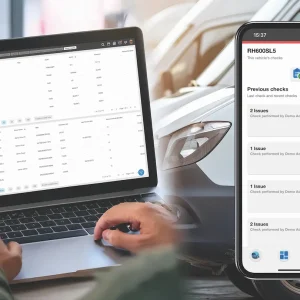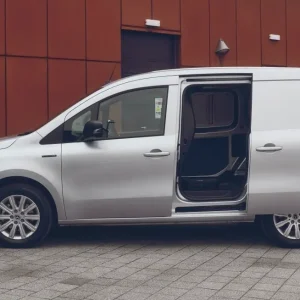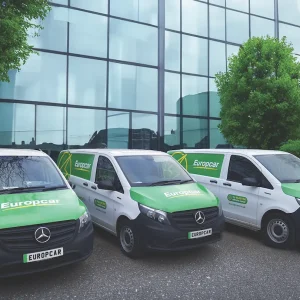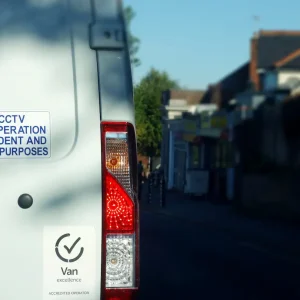The London Borough of Hackney has pioneered the use of green vans in an inner-city environment and its success last year in achieving emission reductions through the use of driver training, telematics, fleet management software, speed limiters, vehicle procurement and specification plus, crucially, the adoption of alternative fuels, saw it capture What Van?’s inaugural Green Fleet award.
The borough’s corporate fleet manager Norman Harding tells What Van? he currently has 291 light commercial vehicles on the fleet, with a breakdown of 138 light vans, 101 medium vans, 11 large vans, two pick-up trucks and a single cherry picker.
“These are nearly all from the Citroen brand,” he says, “but I have one or two Mercedes (Vito medium vans) and VWs (Caddy light vans). Most of our EVs are Nissan (E-NV200s) and I still have a few Fords (Transits), which will be going off fleet shortly.”
Although Hackney’s focus is now switching more to electric power, Harding says one of the reasons he initially opted for Citroen vans was because of their ability to run on the waste-produced biofuel, hydro-treated vegetable oil (HVO).
Up to the tasks
The vans undertake a wide variety of tasks within the east London borough, including housing maintenance, upkeep of parks and open spaces, street cleansing and recycling, providing home library services, market support, and engagement with the community, Harding explains.
Typically, the vehicles are fairly low-mileage – covering from between 4,000 to 6,000 miles a year during the course of their duties – making electric powertrains a viable option.
Other than the cherry picker, Harding says some of the large vans, which are Citroen Relays, have been converted into caged-body tippers, and other conversions include a dog warden van, converted from a Citroen Dispatch, a set of meals-on-wheels vans, and some “very expensive conversions where the vehicles are used for CCTV surveillance”.
He adds: “Most of the conversion work has been done by Tipmaster, who provide high-quality conversion work and are conveniently located for us.”
With pressure growing from the government and mayor of London to reduce the number of diesel vans in the city, Hackney’s green-fleet policy looks increasingly well timed and relevant to the prevalent political climate.
“Hackney has a proud reputation for being one of the leading local authorities in operating alternative fuels. I currently have 47 EVs on fleet,” says Harding.
In the long run Harding envisages the borough’s light commercial vehicle fleet becoming entirely electric, but he acknowledges the technology needs to develop further for this to become a reality in terms of improving range, charging infrastructures and payload capacities of the vehicles available.
Having said that, he points out: “We signed up to the [government and vehicle industry] Go Ultra Low programme a couple of years ago and are one of the first organisations nationally to sign up to the Clean Van Commitment [a pledge van operators make to move towards zero-tailpipe emissions – see ‘Clean Van Commitment’] where we have committed to all our LCVs being ultra-low emission vehicles by 2028. For Hackney I envisage this as being electric unless better technology surfaces in the meantime.”
The Go Ultra Low campaign aims to promote the benefits, cost savings and practicality of electric vehicles to both individuals and fleets. The scheme is funded by the Office for Low Emission Vehicles (OLEV) and backed by the Society of Motor Manufacturers and Traders (SMMT).
While the borough’s goal is to embrace battery power for all its vans, Harding says he has historically taken other low-emission fuels onto the fleet.
“I have operated high-blendbiofuels for years and we are trialling a renewable biofuel called hydro-treated vegetable oil (HVO),” he explains. “The fuel is made from waste vegetable oil and therefore inherently highly CO2-efficient, but we also achieved amazing NOx reductions at the tail pipe.
“I will be initiating a tender for our bulk fuels supply later this year and will run all our HGVs on it. Furthermore, I hope to run our LCVs on it where I cannot yet operate them as electric. This would then make us totally fossil fuel-free.”

Corporate fleet manager Norman Harding
Back to electric
Returning to electric power, Harding says he has installed 45 charging points for Hackney’s fleet of electric light commercials across 13 sites within the borough.
He adds that he chose ‘intelligent’ charging points in order to gather back-office data to support the fleet management operation.
Unfortunately, Harding admits there has been a hitch: “The data has been disappointing as there is no facility to enter mileage. Without the mileage the data cannot be usefully employed,” he says.
“I have raised this issue at many forums that I’m involved with. Many back-office providers offer phone apps for drivers to enter mileage, but this encourages phone use in the vehicles, which I don’t want to do. Others have offered aftermarket telematics that could communicate with the back-office system, but this adds another layer of cost.”
On a more positive note, he reports that the fleet’s drivers are keen to use electric vehicles and will have the means to record mileages.
“We have had great buy-in from our drivers, to the point I have just installed charging points at five of our drivers’ homes that operate vehicles on a 24/7 basis,” Harding says. “The difference with this trial is the intelligent part of the network is built into the charging cable rather than the charging point.
“The provider is developing software to enable the driver to enter mileage at the point of charging. The cable can ID [identify] each charging point, which enables me to separate and calculate the energy used at their home and reimburse their costs accordingly.”
Harding claims that if this trial proves to be a success he will consider converting the borough’s entire electric vehicle charging infrastructure to the same system.
The enthusiasm of the staff for EVs is perhaps more notable because driving is not their primary function; they work in a number of manual and vocational trades.
Some are street cleaners, some are plumbers, electricians or couriers and others work in offices as librarians or IT technicians.
All though, can appreciate the benefits of driving electric vans and as the terchnology improves, this trend is set to continue.
Clean Van Commitment
Backed by the Department for Transport and led by the Global Action Plan charity, the Clean Van Commitment plans to replace 18,000 diesel vans with electric models by 2028.
The coalition of fleets, which includes large organisations such as Tesco, Network Rail, Engie, Anglian Water and the Environment Agency as well as Hackney, Leeds, Gateshead, Waltham Forest and Oxford councils, has pledged to invest £40m in rolling out zero-emission vehicles in the next two years, during which period it has committed to deploying 2,400 electric vans.
Weight gains?
The legal weight for driving an electric van with a standard Category B licence has recently increased from 3.5t to 4.25t, but Hackney Borough’s corporate fleet manager Norman Harding says this has had little impact on his operations because, as yet, there are not many vans
at this weight threshold to choose from.
“Whatever vehicles I operate must be fit for purpose and affordable,” he stresses.
“The few EVs available at this weight are too limited to allow me to operate effectively. I have no doubt they will come, and to this end I have even changed our funding method to outright purchase so that when EVs are affordably available and operationally effective at the heavier weights I have the flexibility to sell vehicles and transition to EV.”
When it comes to keeping the fleet legal and roadworthy, the service, maintenance and repair requirements for all Hackney’s LCVs are covered by a combination of an in-house workshop within the borough’s boundaries and an external contractor based at a satellite workshop.
“This delivery model gives me close control of the maintenance function, flexibility in terms of resource and helps keep my overheads low,” explains Harding.





